Pediatric Dental Software: Streamlining Niche Clinic Management
Pediatric dental clinics face unique challenges, from managing primary teeth tracking to reducing child anxiety during visits. Generic dental software often falls short in addressing these needs. Pediatric dental software offers tailored solutions, including age-specific recalls, guardianship management, and customisable odontograms. These tools improve clinic efficiency, enhance parent communication, and ensure compliance with UAE regulations like NABIDH.
Key highlights of pediatric dental software:
- Primary teeth tracking: Clear visual charts for mixed dentition.
- Parent portals: Simplify communication with treatment plans and progress updates.
- Child-friendly tools: Educational games, VR/AR features, and visual treatment plans to ease anxiety.
- AI diagnostics: Simplify X-ray findings for parents, boosting treatment acceptance by up to 25%.
- Cloud-based access: Real-time updates for seamless team collaboration.
For UAE clinics, compliance features like secure record-keeping and data encryption ensure adherence to local regulations. By choosing pediatric-specific software, clinics can reduce administrative burdens, improve patient satisfaction, and create a smoother experience for families.
Oryx Dental Software: How Dr. Milca Mendez-Ceballos DDS, Simplifies Pediatric Dentistry
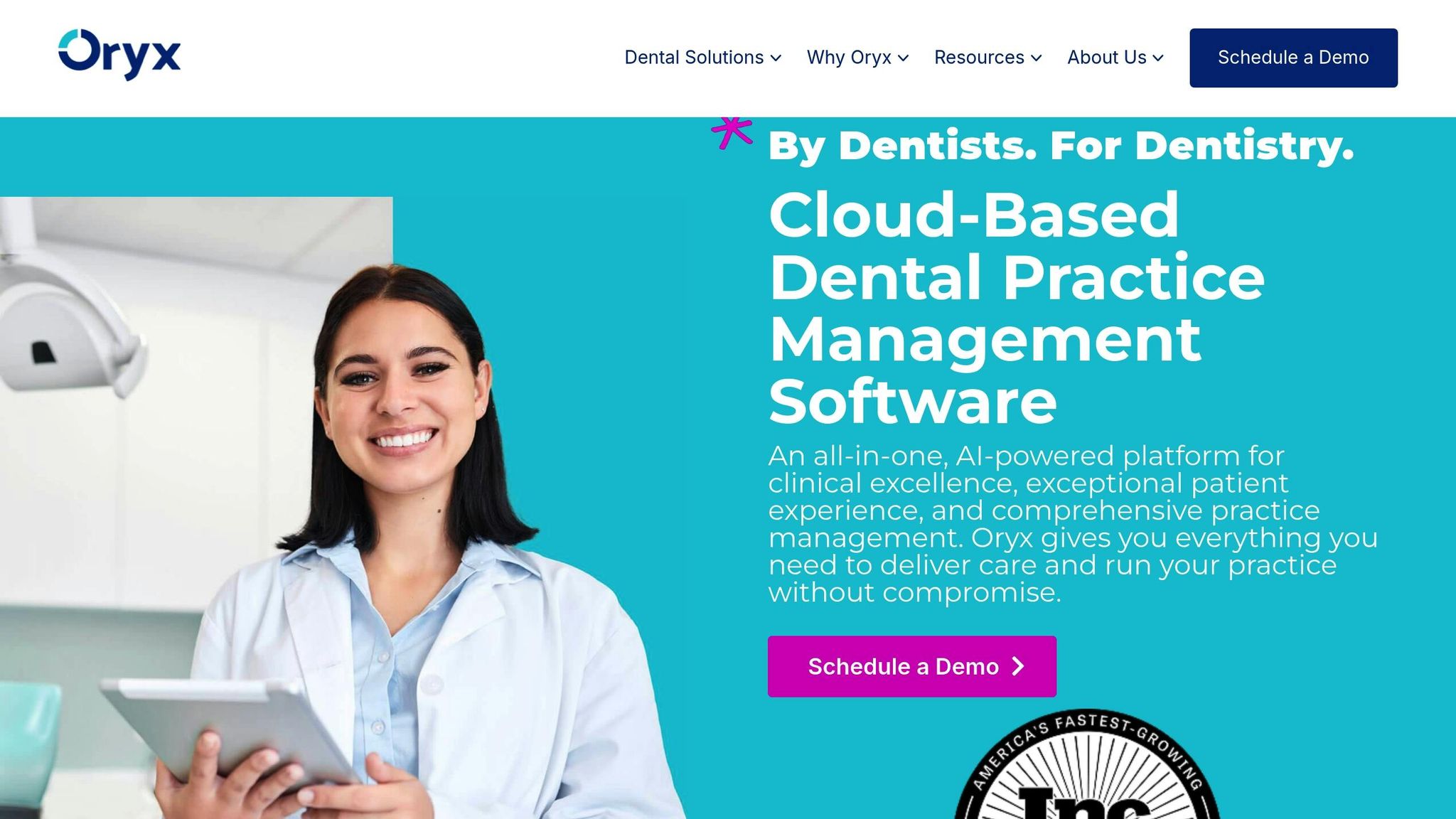
What Is Pediatric Dental Software and How It Helps Niche Clinics
Pediatric dental software is a specialised practice management tool designed specifically for the unique needs of children’s dental care. Unlike general dental software, these systems excel at managing primary teeth tracking, guardianship setups, and child-specific treatment planning. They address challenges like mixed dentition cases and parent communication, which can be cumbersome for standard software. Let’s take a closer look at the common hurdles pediatric clinics face.
Common Challenges in Pediatric Dentistry
Operating a pediatric dental clinic comes with its own set of challenges that generic software often fails to address. A major issue is managing child anxiety. Young patients are frequently nervous or uncooperative, making routine appointments more complex than they would be with adults.
Another difficulty lies in tracking the transition from primary to permanent teeth. Children’s mouths change quickly as baby teeth are replaced by adult teeth, creating a moving target for treatment planning. Standard dental charts often fail to capture this dynamic process, leading to gaps in care.
Communicating with parents is also a unique challenge. Unlike adult patients who make their own decisions, pediatric care involves a three-way interaction between the dentist, the child, and the parent or guardian. Parents require clear, easy-to-understand explanations about their child’s oral health and proposed treatments.
Additionally, guardianship documentation can be a significant administrative burden, especially in the UAE. Clinics must carefully track who has legal authority to approve treatments, which can be complicated in cases involving divorced parents or extended family members.
These challenges highlight the need for specialised tools that cater to pediatric dental practices.
How Pediatric Dental Software Solves These Problems
Pediatric dental software is designed to address these specific challenges, offering solutions tailored to the needs of young patients, their parents, and clinic staff.
Customisable odontograms are a standout feature, allowing dentists to clearly differentiate between primary and permanent teeth. These detailed visual charts make it easier for parents to understand their child’s oral development and treatment needs at a glance [2][5].
Parent portals simplify communication by providing clear reports and treatment updates. Instead of relying on complex dental jargon, dentists can share visual progress reports that are easy for parents to grasp. This transparency not only builds trust but also boosts treatment acceptance rates.
Age-specific recall systems take the guesswork out of scheduling follow-ups. For example, a 6-year-old getting their first permanent molars will have different recall intervals compared to a teenager with braces. These systems ensure that appointments are tailored to each child’s developmental stage [2][5].
To alleviate child anxiety, many systems include interactive features like educational games and visual treatment plans. Some even integrate with VR/AR technologies, such as Remedico’s Dentaverse®, which presents treatment plans in an engaging, kid-friendly way.
“When I present treatment plans using Dentaverse, my patients are left speechless. It’s an incredible tool!” - Dr. Khalil Karam, Fujeirah, UAE [1]
AI diagnostic tools further enhance parent communication. Solutions like Overjet overlay X-rays with visual indicators for enamel, pulp, and past treatments, making complex findings easier for parents to understand. Clinics using these tools report a 25% increase in case acceptance rates on average [6].
Cloud-based access supports the collaborative nature of pediatric care. Staff can update patient records in real-time, whether they’re at the front desk, in the treatment room, or contacting parents about appointments [5].
Feature | General Dental Software | Pediatric Dental Software |
|---|---|---|
Primary Teeth Tracking | Limited | Comprehensive, age-specific |
Parent Communication Tools | Basic | Advanced, with portals/reports |
Child Anxiety Management | Not included | Games, visuals, behaviour tools |
Growth Tracking | Not specialised | Built-in, with charts/recalls |
Guardianship Setup | Rare | Standard |
Lastly, automated billing simplifies the often-complex process of handling pediatric insurance claims and family payment plans. Since many parents manage dental care for multiple children, this feature is crucial for maintaining smooth cash flow in the clinic [3].
Key Features of Pediatric Dentistry Practice Management Tools
Modern pediatric dental software offers much more than just appointment scheduling and billing. These platforms are designed to tackle the unique needs of treating children, with tools that track tooth development, engage young patients, and keep parents informed every step of the way.
Specialized Dental Charts and Growth Tracking
Tracking primary teeth is a key feature of any effective pediatric dental software. These systems use clear, easy-to-read symbols to highlight tooth rotations, damage, and other issues specific to growing mouths. They also visually differentiate between baby teeth (deciduous) and permanent teeth, making it simple for staff to interpret the data quickly and accurately [5].
Growth tracking tools add another layer by monitoring changes over time. This allows dentists to anticipate future treatment needs and implement preventive strategies at the right stages of development. It’s more than just charting; it’s about gaining insights that can shape better care plans [4].
These features not only boost clinical precision but also save time when explaining treatments to families, making patients more likely to return for follow-ups.
Parent Portals and Communication Tools
Beyond clinical tracking, strong communication tools are essential for smoother clinic operations.
Remote consent signing is a game-changer, letting parents sign treatment forms, financial agreements, and medical updates digitally from home. This reduces delays during appointments and lightens the administrative load for staff [2][7].
Digital paperwork is another convenience, sent to parents before appointments so they can complete it at their own pace. This feature is especially helpful for working parents who might struggle to arrive early to handle administrative tasks [7].
Centralised family accounts simplify managing care for multiple children. Parents can access treatment plans, appointments, and billing information for all their kids in one place, cutting down on confusion and making communication more efficient [2].
Additionally, progress tracking and customisable reports give parents a clear picture of their child’s oral health. Instead of using complicated dental jargon, these reports rely on simple language and visuals, helping parents better understand and trust the recommended treatments [2].
Visual Treatment Planning and Child Engagement
Engaging young patients is just as important as informing their parents, and interactive visual tools make this easier.
Interactive treatment planning tools bring procedures to life. For example, platforms like Remedico’s Dentaverse® use virtual reality to explain complex treatments in a way that’s easy for children to grasp and accept.
Children can also personalise their experience through customisable interfaces, choosing content, graphics, and interaction styles that make them feel more in control. This sense of ownership can significantly reduce anxiety during visits [4].
Another standout feature is 3D dental charts, which offer detailed visualisations of dental conditions. These charts make it easier for both kids and parents to understand why a treatment is needed and what the results will look like, often leading to higher acceptance rates.
Finally, behaviour management tools help dentists track which engagement strategies work best for individual patients. Whether it’s a specific game, video, or interactive tool, the software records what calms each child, enabling staff to create a personalised approach for future visits [2][4].
These tools not only enhance the child’s experience but also streamline the dentist’s workflow, creating a more efficient and welcoming environment for everyone involved.
Smart Technology Integration in Pediatric Dental Clinics
Smart technology is transforming pediatric dental clinics, making treatments more precise and visits less intimidating for children. From AI-driven cavity detection to virtual reality tools, these advancements are helping dentists deliver better care while keeping young patients engaged and at ease. By enhancing workflows and improving communication with parents, these technologies are reshaping diagnosis and treatment planning in pediatric dentistry.
AI-Powered Diagnostics and Cavity Detection
AI diagnostic tools are revolutionising early detection and helping parents better understand their child’s dental health. For instance, Overjet’s FDA-approved AI platform can detect decay in children as young as 4, showcasing the potential of these systems [6].
This technology analyses X-rays and uses colour-coded overlays to highlight issues. By replacing traditional black-and-white images with clear visuals, it becomes much easier for parents to grasp what’s happening in their child’s mouth. This clarity speeds up decision-making during appointments and aligns perfectly with child-focused workflows [6].
But it doesn’t stop at spotting cavities. These tools can also map out enamel, pulp, and previous dental treatments, giving dentists a complete snapshot of a child’s oral health. This thorough analysis helps create more accurate treatment plans and addresses small issues before they escalate [6].
Teledentistry and Smart Device Integration
Teledentistry platforms are a game-changer for busy families, making it easier to access care without frequent clinic visits. Parents can handle follow-ups, ask about minor concerns, and get oral health advice from the comfort of home [8].
Adding to this convenience, smart toothbrushes are tracking kids’ brushing habits in real time. These devices monitor how often children brush, their brushing duration, and whether they’re using the right technique [4]. The data integrates directly with the clinic’s management software, giving dentists a clear picture of each child’s at-home care routine.
This connectivity allows for tailored feedback during visits. Instead of generic advice like “Brush twice a day”, dentists can say, “You brushed for 90 seconds yesterday morning - let’s aim for the full two minutes.” This specific, data-backed approach resonates more with both children and their parents [4].
Remote monitoring also strengthens preventive care. If the software notices a drop in brushing frequency, the clinic can send reminders or arrange a quick check-in before any issues arise [4].
Games and Behaviour Management
Smart technology isn’t just about diagnostics and remote care - it’s also making dental visits more enjoyable for kids. Interactive games and reward systems are helping reduce anxiety while teaching proper oral hygiene. These tools go beyond simple distractions; they’re designed to make dental care both fun and educational [4].
Many pediatric dental platforms now include behaviour tracking features that record which strategies work best for individual patients. For example, if a specific game calms a child, the software remembers this for future visits, enabling staff to personalise the experience [4].
Virtual reality experiences are another powerful tool, helping children understand their dental conditions and treatments in an engaging and non-threatening way. By turning potentially scary procedures into interactive learning moments, these tools significantly ease anxiety [1].
Clinics using game-based features often report higher patient satisfaction and better online reviews. Kids start associating dental visits with positive experiences, which not only benefits them but also reassures parents who see their children feeling comfortable and engaged [4].
These tools also provide real-time insights into what educational content works best for different age groups, allowing clinics to continually refine their strategies and deliver better experiences over time [4].
sbb-itb-d8b42ea
How to Switch to Pediatric Dental Software
Switching to pediatric dental software doesn’t have to be overwhelming. With careful planning and the right tools, the transition can be smooth and efficient.
Choosing the Right Software for Your Clinic
When selecting pediatric dental software in the UAE, ensure it complies with NABIDH standards. This is a key requirement set by the Dubai Health Authority to safeguard patient data and ensure proper handling and storage practices. Meeting this standard not only protects your clinic but also builds trust with your patients [9].
Look for software that caters specifically to pediatric dentistry. Features like pediatric charting, growth tracking, and age-specific recall schedules are essential. These tools are designed to address the unique needs of younger patients, offering benefits that generic dental software simply can’t match [5].
Parent communication features are just as crucial. Opt for software that allows digital consent forms and provides easy access to treatment plans. Tools that let you link siblings under a single account can also save significant administrative time [7].
Compatibility is another factor to consider. The software should integrate seamlessly with your existing systems, such as digital X-rays and accounting tools, and it should support AED currency, metric measurements, and DD/MM/YYYY date formats. For clinics with multiple locations, cloud-based solutions offer greater flexibility and accessibility [5].
Additionally, Arabic language support can enhance communication with local families, making your services more inclusive. Once you’ve chosen the right software, the focus shifts to smooth data migration and effective staff training.
Planning Data Migration and Staff Training
Transferring patient records securely is a critical step. Use encrypted, cloud-based migration tools to transfer treatment histories, family links, and pediatric charting for both primary and permanent teeth [5]. Providers like Curve Dental and Oryx offer centralised EHR integration to simplify this process [9].
Plan the migration during quieter periods to minimise disruptions. Real-time collaboration tools can help validate data as it’s transferred, ensuring everything is accurate and complete.
Staff training is just as important. Each team member - whether a dentist, front-desk staff, or hygienist - has unique needs. Hands-on workshops during off-peak hours can help everyone get comfortable with the new system. Providing access to demo environments allows your team to practice without affecting live patient data [9].
“My workflow is now efficient. Remedico stands apart from other dental software, and I highly recommend it!” - Dr. Ahmad Khuzae, Dubai, UAE [1]
Choose software with an intuitive interface to reduce the learning curve. Providers that offer ongoing support - like video tutorials, live chat options, and dedicated support teams - can make the transition even smoother. Involving staff in customising workflows can also boost adoption and reduce errors during the switch [1].
A well-planned migration and thorough training process are critical to ensuring your clinic’s operations remain seamless.
Measuring ROI and Success Metrics
After the switch, tracking key metrics can help you measure the success of your new software. Start by evaluating appointment efficiency. Are scheduling errors, double-bookings, or time spent on admin tasks decreasing? Many clinics report noticeable improvements shortly after implementation [6].
Pay attention to patient retention rates and parent satisfaction. A good system should streamline scheduling, improve treatment acceptance, and enhance overall retention. Metrics like appointment show-rates, treatment plan acceptance, and online reviews can provide valuable insights [7].
Digital tools that visualise treatment plans often lead to higher case acceptance rates. AI-powered diagnostics can also play a role by identifying issues earlier and presenting findings more clearly to families. For example, studies show that 100% of dentists using AI tools like Overjet report better diagnostic outcomes [6].
Financial benefits are another area to monitor. These include time saved on paperwork, fewer missed appointments, and improved compliance during audits. Regular feedback sessions with staff and patients can help identify areas for improvement, ensuring you get the most out of your software investment.
Successful clinics often schedule periodic reviews to refine workflows and maximise their return on investment.
What Most Pediatric Clinics Get Wrong About Practice Management Software
Pediatric dental clinics in the UAE often make critical mistakes when it comes to choosing and implementing practice management software. These errors usually arise from overlooking the specialised needs of pediatric dentistry and underestimating how technology can simplify managing young patients and their families. Below, we break down three common missteps that can hinder a clinic’s efficiency and patient care.
Choosing Generic Software Instead of Pediatric-Specific Solutions
One of the most frequent errors is opting for generic dental software that isn’t tailored to the needs of pediatric dentistry. Unlike pediatric-specific tools, generic systems lack essential features like age-appropriate recall systems, primary teeth tracking, and guardianship setup options [2][5].
Guardianship setup is particularly critical in pediatric practices. Unlike adult patients, children require consent from parents or guardians, and generic systems often fail to address this need adequately. This oversight can lead to compliance issues and complicate the treatment consent process [2][5].
Additionally, generic software often falls short in behaviour management tools. Pediatric dentists, who frequently deal with energetic or anxious children, benefit from software that’s intuitive and easy to navigate. Struggling with a cumbersome system takes attention away from the child, making the visit more stressful for both the dentist and the patient [2]. Another drawback is the lack of customisable odontograms, which are invaluable for helping parents visualise their child’s oral health. Without these, clinics may see lower case acceptance rates [2][5].
These shortcomings often result in hidden costs that outweigh the initial savings of choosing a generic system. Inefficient workflows and a lack of child-specific features can significantly impact a clinic’s ability to provide quality care.
Overlooking the Role of Parent Communication
Another common mistake is underestimating how much parent communication influences the clinic’s success. Poor communication tools can lead to lower treatment acceptance rates and reduced lifetime value of patients.
Effective practice management software should include features like progress tracking, growth charts, and clear, easy-to-understand reports. These tools not only help parents stay informed but also ensure that children develop positive attitudes toward dental care [2]. Pediatric practices that skip these features often struggle because they’re not just educating the patient - they’re also educating the parents, who play a key role in maintaining their child’s oral health [2].
“Remedico has helped us with the work flow by creating simple and creative software with sleek design, the support team always available and solved all the requirements we had. Dr. Enas switched to Remedico from paper and Google Sheets, was amazed by the use of ‘Observe reminders’, which significantly boosted patient retention rate.” - Dr. Enas, Dentist, Ras Al-Khaimah, UAE [1]
Neglecting strong parent communication features can have long-term consequences. It weakens the relationship between the clinic and its patients, reduces understanding of dental conditions and treatments, and ultimately affects both patient retention and clinic revenue.
Skipping Training and Workflow Integration
The final major mistake is implementing new software without proper training or redesigning workflows to accommodate it. Without adequate preparation, clinics often face inefficiencies that defeat the purpose of investing in the software.
This issue is even more pronounced in pediatric dentistry, where coaxing children to cooperate is already a challenge. A complex or poorly integrated system adds unnecessary stress for staff and patients alike [2]. The easier the software is to use, the more staff can focus on behaviour management instead of wrestling with technology [2].
Another frequent oversight is failing to establish clear accountability within the software. Pediatric-specific systems can track who performed each charting task, making it easier for managers to address any questions or concerns later [2]. Additionally, many clinics don’t take full advantage of real-time collaboration features that allow team members across multiple locations to update records simultaneously [5]. Without proper training on these workflows, staff often revert to manual processes, leaving the software’s potential untapped.
Resistance to change is another common hurdle. Without dedicated time for training and a willingness to adapt workflows, staff frustration can lead to the abandonment of the new system. However, with the right training and integration, pediatric-specific software can improve both patient care and operational efficiency, making the investment worthwhile in the long run.
Key Takeaways for Pediatric Dental Software Adoption
When it comes to choosing pediatric dental software, it’s essential to prioritise features tailored specifically for children rather than settling for generic dental solutions. Key functionalities like primary teeth tracking, age-specific recalls, customisable odontograms, and guardianship setup are indispensable. These tools address the unique needs of paediatric dentistry - something that standard dental software often struggles to manage effectively [5][2].
Communication tools designed for parents can also make a world of difference. Features like family grouping for appointment reminders and remote digital paperwork not only help reduce missed appointments but also boost treatment acceptance rates [7][2].
Quick Evaluation Checklist for Clinic Owners
Here’s a handy checklist to ensure your software meets the needs of your paediatric clinic:
- Primary and mixed dentition charting with growth tracking
- Parent portal for easy communication and remote paperwork
- Compliance tools for local regulations, such as NABIDH in Dubai
- Visual treatment planning to engage young patients
- User-friendly interface for quick adoption by staff
- Comprehensive audit trails for accountability and record-keeping [5][2]
Cloud-based access and real-time collaboration features are also game-changers. They allow your team to operate seamlessly across multiple locations while ensuring secure, compliant data storage [5]. This flexibility becomes even more valuable as your practice expands or if you manage several clinics.
Proper training is crucial - it transforms software from a simple operational tool into a revenue-driving asset.
To measure success, focus on tangible metrics like appointment no-show rates, parent satisfaction scores, treatment acceptance rates, and staff efficiency improvements [7][2]. By tracking these numbers before and after implementation, you can evaluate your investment’s impact and pinpoint areas for further improvement.
The right pediatric dental software doesn’t just streamline operations - it enhances patient care and strengthens relationships with families. With these tools in place, your clinic can reduce administrative tasks, improve patient education, and create a more predictable revenue stream, all while integrating smoothly into your existing workflow.
FAQs
What makes pediatric dental software better suited for children’s dental clinics compared to general dental software?
Pediatric dental software is crafted to meet the specific demands of children’s dental clinics, offering features that cater directly to young patients. Unlike generic dental software, these tools are tailored to manage child-centric treatment plans, track growth milestones, and create a welcoming, kid-friendly atmosphere.
Take pediatric-focused features, for instance. These often include behaviour tracking to better understand young patients, customised reminders for parents to keep them informed, and visual aids that simplify explaining treatments to children. Many systems also come equipped with compliance tools designed to meet regional regulations, such as those in the UAE, ensuring clinics maintain both professionalism and a family-friendly approach.
Using software designed for pediatric dentistry helps clinics enhance patient retention, optimise daily operations, and foster a more comforting environment for children and their families. :::
How does pediatric dental software help reduce anxiety for children during dental visits?
Pediatric dental software is crafted with features that make dental visits more welcoming and enjoyable for children. Take, for instance, customised appointment reminders that come with playful designs - these can turn what might feel like a daunting visit into something children look forward to. Another standout feature is the inclusion of interactive educational tools. These tools break down dental procedures in a fun and engaging way, helping little ones feel more relaxed and informed.
What’s more, many of these platforms offer child-friendly scheduling options. This means shorter waiting times and appointment slots that align with times when children are naturally more cooperative, helping to keep stress levels low. By tailoring processes to the needs of young patients, pediatric dental software enables clinics to create a calm, family-friendly atmosphere that prioritises comfort and care. :::
How does pediatric dental software help clinics in the UAE comply with NABIDH regulations, and what are the benefits?
Pediatric dental software streamlines compliance with UAE regulations, such as NABIDH, by automating essential tasks like managing patient data securely, maintaining precise documentation, and generating reports that are ready for audits.
By minimising manual errors and cutting down on administrative tasks, clinics can dedicate more time to patient care while safeguarding data and adhering to regulatory requirements. This approach not only helps prevent penalties but also enhances patient trust by promoting greater transparency and operational efficiency. :::

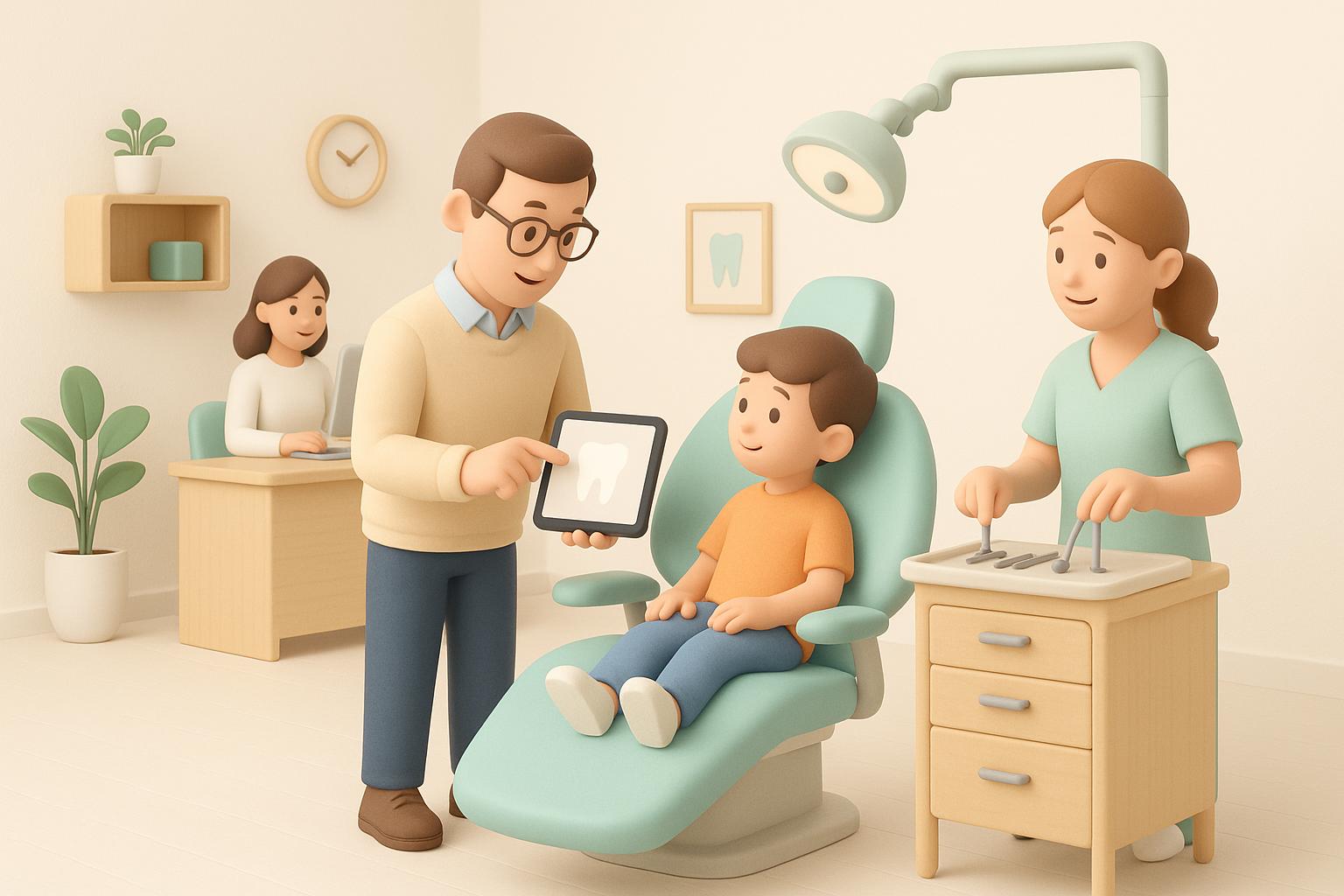
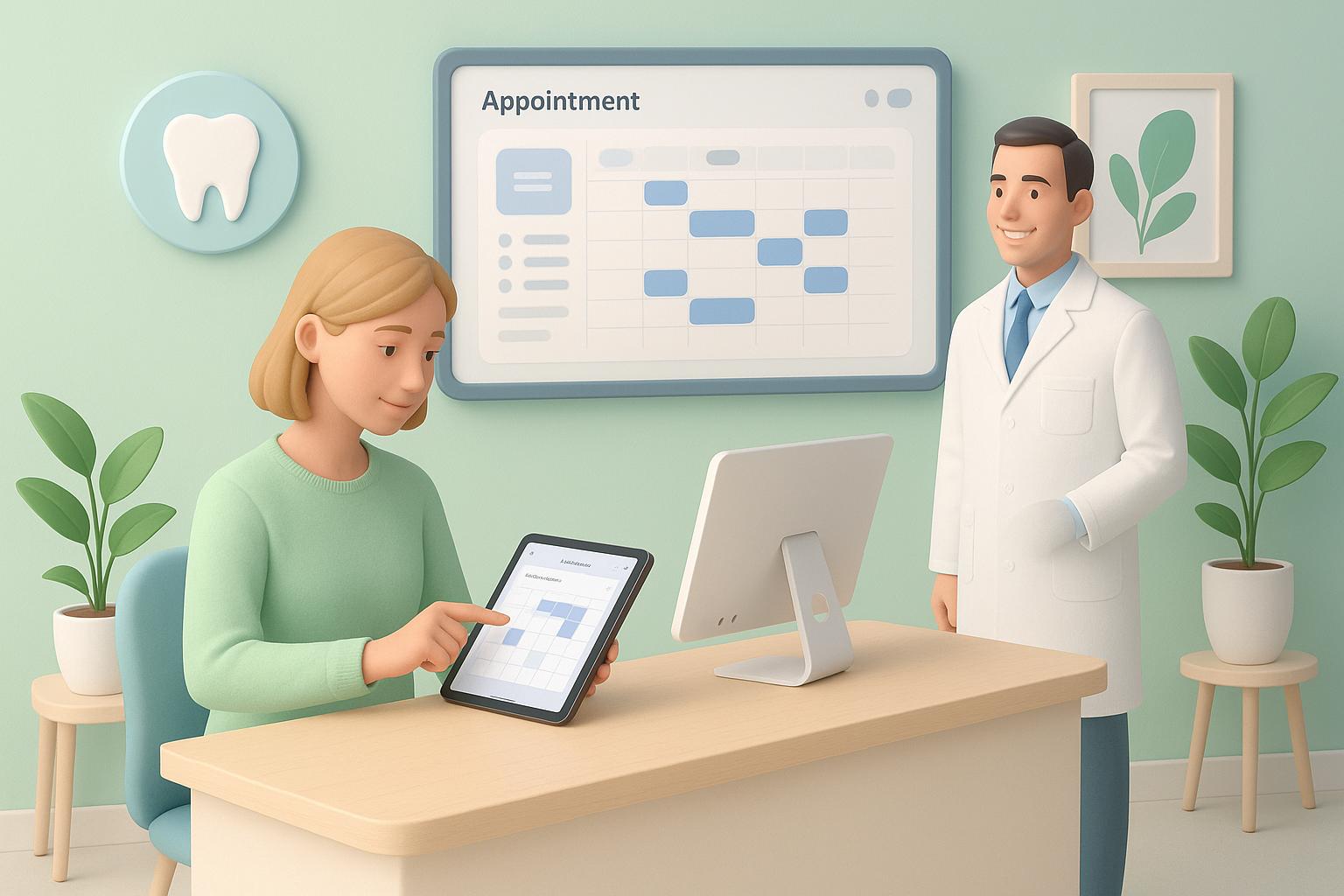
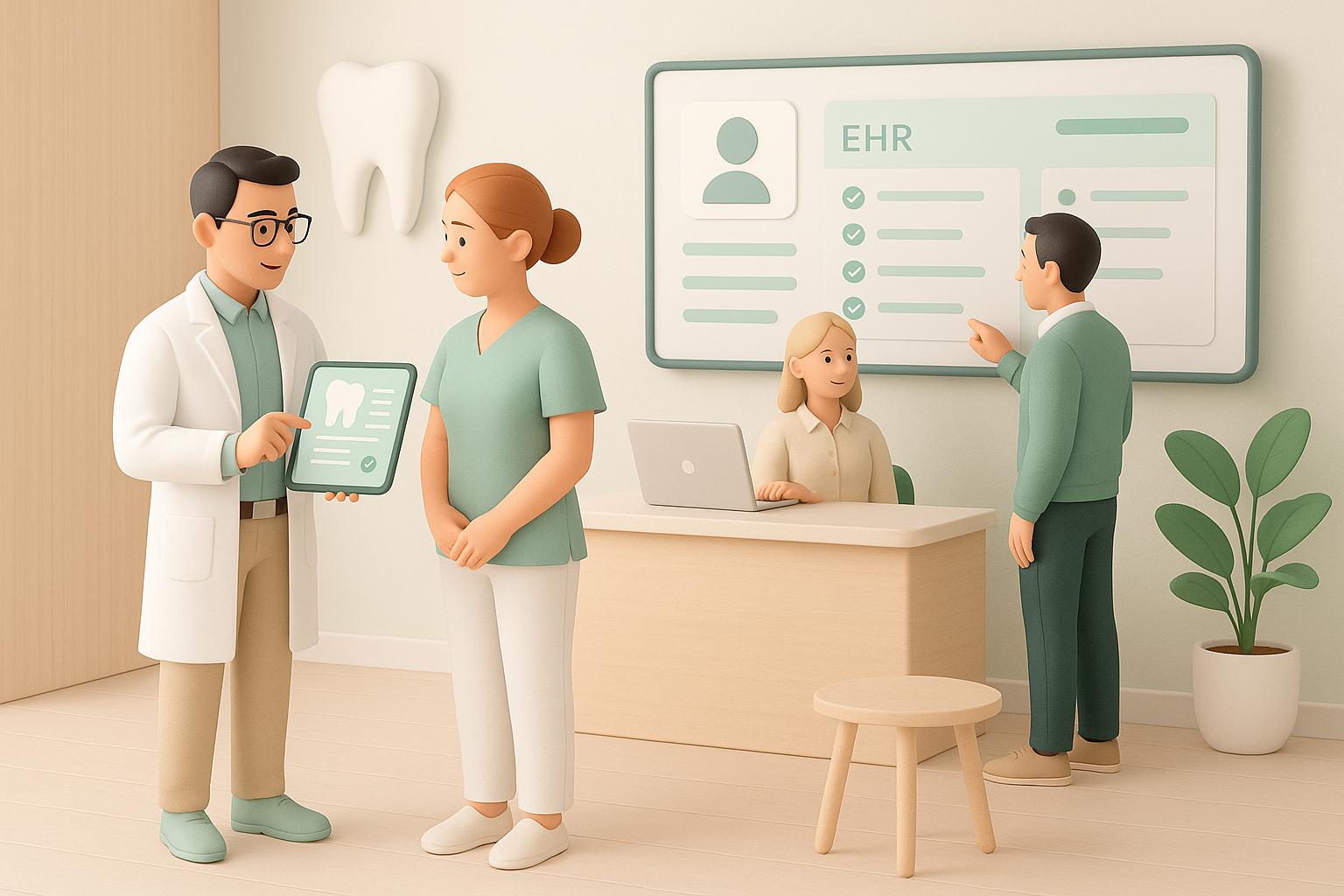
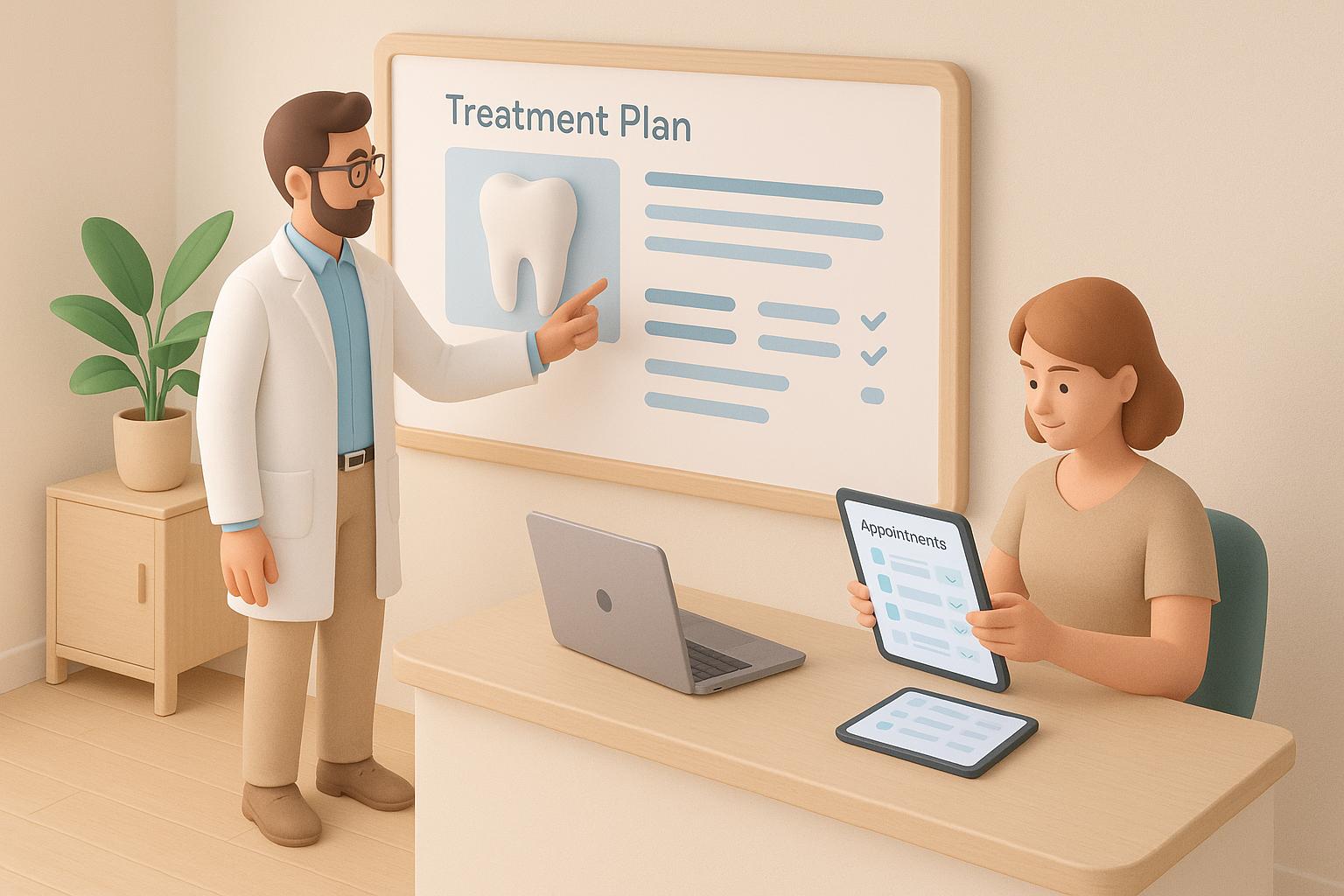


 International
International  UK
UK  Kuwait
Kuwait  Nigeria
Nigeria  Kenya
Kenya  Japan
Japan  USA
USA  France
France  UAE
UAE  South Africa
South Africa  Ethiopia
Ethiopia  Australia
Australia  Canada
Canada  Germany
Germany  Bahrain
Bahrain  Egypt
Egypt  India
India  Pakistan
Pakistan  Mexico
Mexico  Switzerland
Switzerland  Qatar
Qatar  Algeria
Algeria  Angola
Angola  Malaysia
Malaysia  Argentina
Argentina  Italy
Italy  KSA
KSA  Morocco
Morocco  Ghana
Ghana  Indonesia
Indonesia  Brazil
Brazil  Austria
Austria  Turkey
Turkey  Côte d’Ivoire
Côte d’Ivoire  South Korea
South Korea  Colombia
Colombia 

































